History
Family/Brewery History
Click on any of the years in the timeline to read about the historical highlights of the Brewery Blocks. The back arrow will return you to the beginning.
- 1856–2000
- 1856–62
- 1862–64
- 1865–72
- 1880s
- 1890s
- 1900–04
- 1904–10
- 1914–33
- 1928
- 1929
- 1930s
- 1940s
- 1950s
- 1960s
- 1968
- 1970s
- 1979–99
- 1999
- 2000
Key Dates in the History of Blitz-Weinhard Brewery 1856–2000
Blitz-Weinhard brewery, recognized April 1, 1856, as the start of the West’s oldest, continuously operating brewery. It operated at its West Burnside location from 1864 through September 1999.
1856–62 Brewery Founded

The story began in 1856 when German-born Henry Weinhard (1830-1904) arrived in the Portland-Vancouver area from Cincinnati, where he had worked in local breweries. He decided Ft. Vancouver was a good place for the brewery business because of its proximity to a reliable market – soldiers. He went to work for Meunch’s Brewery.
Later that year he moved to Portland and became a business partner with George Bottler, establishing Portland’s second brewery at the corner of Northwest Couch Street and First Avenue. Business proved disappointing and Weinhard disposed of his interest, returning to Meunch’s in Vancouver, which he purchased six months later.
1862–64 Portland Breweries Purchased
In 1862, Weinhard sold Meunch’s and moved to Portland again. He purchased Oregon’s oldest brewery, Liberty Brewery – established by Henry Saxer in 1852, which was located at Northwest First and Davis. Weinhard purchased George Bottler’s City Brewery holdings in 1864, located on two blocks at West Burnside and 12th in Couch’s Addition. Weinhard moved his operations to West Burnside and operated from City Brewery’s small facilities.
1865–72 Expansion
Starting in 1865 a series of industrial buildings were built, including a nine-story Brewhouse. City Brewery expanded and outpaced its competitors. In the late 1860s Henry Weinhard’s lager became famous throughout Northwest saloons, with sales in Montana, Seattle and California. With Portland established as a seaport, Weinhard sales extended to China, The Philippines, Japan and Siberia.
Two additional blocks in Couch’s Addition next to City Brewery were purchased.
1880s More Expansion
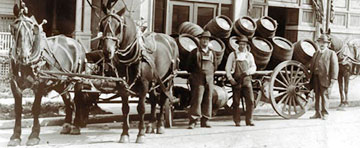
City Brewery experienced constant sales expansion and facilities growth to meet the demand.
Weinhard volunteered to pipe beer from the brewery to Skidmore Fountain so the fountain could run suds on its dedication day. City fathers politely declined the offer.
1890s A Taste for Beer
After 1890, beer surpassed distilled spirits as the principal source of beverage alcohol in the American market. An offer was made from English businessmen in the 1890s to buy City Brewery. Weinhard turned down their offer of $1,175,000.
Over the years Weinhard’s stature in Portland grew. An incident in 1894 illustrates that point. The national economic depression that started a year earlier had Portland banks, and their customers, in a panic. Anxious depositors formed a long line at one bank, ready to withdraw their cash. As the story goes, Weinhard walked to the head of the line and announced in a loud voice that he wished to make a large deposit. The line soon disappeared.
On Jan. 16, 1899, "The Oregonian" published a major feature on Weinhard’s brewing empire. The story noted the brewery, covering a two-acre site, produced 100,000 barrels of beer annually.
1900–04 New Brewhouse Planned
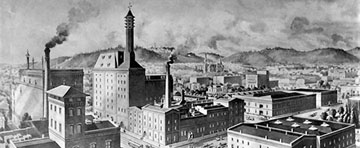
In the first years of the new century Weinhard’s thoughts turned to constructing a new Brewhouse. His vision included a brewmaster’s office featuring fine murals and woodwork. The design was included in the new building constructed after his death.
1904–10 Weinhard Dies, Blitz Arrives
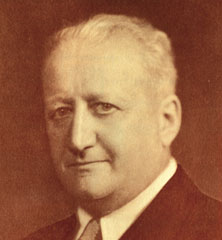
Weinhard died in 1904 and the business passed down to his sons-in-law, Paul Wessinger and Henry Wagner. Weinhard’s death was prominently displayed on the front page of “The Oregonian” on Sept. 5, 1904.
Two red-brick buildings on Northwest 12th between West Burnside and Northwest Couch were completed in 1908 to serve as the Brewhouse and the malt and hop building. They stand today as the oldest parts of the brewery complex. They were designed by Whidden and Lewis, the architects responsible for Portland City Hall (1895) and many other important early 20th Century buildings in Portland.
At some point over the years the Burnside complex became better known as Henry Weinhard’s Brewery. This was the name etched in stone atop the new Brewhouse.
Wessinger served as president from 1904 until his death in 1926. He was active in community affairs and helped select the Northwest Portland site for the 1905 Lewis and Clark Exposition.
A Studebaker executive, Arnold Blitz (1882–1940), arrived from Colorado after purchasing a half interest in the Portland Brewing Company, one of Weinhard’s competitors. Its chief product was Edel Brau. After several years in partnership, Arnold Blitz bought out Mr. Edel’s interest. The product was renamed “Blitz, the beer that fits.”
1914–33 Prohibition in Oregon
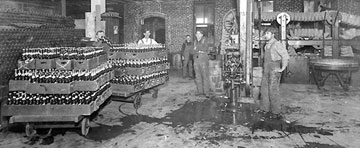
Newly enfranchised women voters in Oregon helped pass a statewide prohibition on the manufacturing and sale of liquor in 1914, five years before Congress ratified the 18th Amendment imposing a nationwide ban on the sale of spirits. To survive, the Weinhard brewery turned to making non-alcohol products such as near beer – a brew of less than 0.5 percent alcohol – syrups and soft drinks – such as root beer, becoming a local bottler of national brands. Vanilla cream and other syrup products were marketed as “gourmet elixirs.”
Before Prohibition, most breweries owned the saloons, or at least the land under them, where their beer was sold. The Weinhard brewery owned property from Canada to San Francisco. In fact, the brewery signed a 30-year lease on San Francisco waterfront property just before Prohibition. Many of these company-owned properties were foreclosed on because the brewery couldn't pay the taxes, says William W. Wessinger, Weinhard’s great-grandson. Portland Brewing’s Blitz defied the odds and actually built a new brewery at Northwest 20th and Upshur. Blitz made near beer, too.
Paul Wessinger died in 1926 and his son, Henry – Weinhard’s grandson, took over management of the brewery. In 1928, with Al Smith, the Democratic nominee for President running on a platform to repeal Prohibition, Wessinger began thinking about how to rebuild the beer business. Weakened from Prohibition’s impact on business, City Brewery looked for new resources.
1928 Merger with Blitz

City Brewery and Portland Brewing merged. Arnold Blitz became chairman and Henry Wessinger was named vice chairman of the new Blitz-Weinhard Brewing Company. Smith lost the election and Prohibition continued. Blitz served as president until 1940.
1929 Auto Dealership Constructed
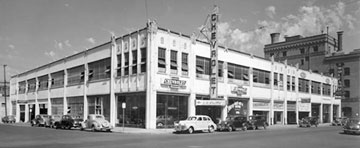
Weinhard’s old nine-story Malt House between 12th and 13th on West Burnside was torn down in 1928 to make way for construction of an auto garage. The building later became an auto dealership – A. B. Smith Chevrolet was one of its occupants. The garage later became part of the brewery.
1930s Prohibition Ends

Prohibition ended in April 1933 when Congress ratified the 21st Amendment. The least amount of money lost in any year during Prohibition was $10,000, notes Bill Wessinger.
Beermaking resumed and Blitz beer became the brewery’s leading product. At first it was brewed at the Northwest 20th and Upshur facility and shipped to Burnside for bottling. Eventually the Upshur brewery was closed and improvements gradually were made to the Blitz-Weinhard plant.
By the late 1930s production reached 49,000 barrels a year, half the production of the turn-of-the- century. It really took the brewery about 20 years to recover and modernize after Prohibition, Bill Wessinger says.
1940s Henry Wessinger Takes Over

Weinhard’s grandson, Henry Wessinger became president and led Blitz-Weinhard on a modernization process following the end of the Depression. He served as president until 1955.
1950s Oldest in the West

By 1952, Blitz-Weinhard could make the claim of being the oldest, continuously operated brewery in the West. A year later Fred Wessinger, Bill’s brother, enticed Dr. Max Zimmermann – a respected brewmaster – to move from the Blatz brewery in the Midwest to Blitz. He led Blitz-Weinhard on a quality improvement drive, upgrading facilities and the product.
J.M. Rothchild, Arnold Blitz’s brother-in-law, was named president in 1955. In 1956, a time capsule was buried at the brewery to celebrate 100 years of business. The capsule was to be opened in the year 2056.
The brewery retained nationally known consultants – marketing researcher Elmo Roper and Associates and designer Walter Landon. The result for the century-old brewery was a new growth strategy and a colorful new label for Blitz beer.
1960s Sustained Growth
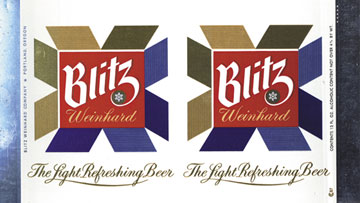
The late 50s and 60s was a time of sustained growth for the brewery. A new generation of both families had moved into top management positions. Being a Blitz or a Wessinger meant visibility, sometimes unwanted. One teenage member of the Blitz family was with some high school boys apprehended for buying beer. She was detained, too. She was uncertain, she said, what the police would charge her with. Being a minor in possession of alcohol. Or, being a Blitz in the possession of Olympia Beer.
By the end of the 60s, Blitz-Weinhard had captured 30 percent of Oregon beer market sales. Blitz products, including Old English 800 malt liquor and Bohemia Club, a low-end beer, occupied 50 percent of Fred Meyer shelf space dedicated to beer sales.
1968 Portland Armory Purchased

A landmark built in 1889, the Portland Armory, was purchased by the brewery in 1968 for use as a warehouse. Originally built by Multnomah County, the armory served as home for the Oregon National Guard. Soldiers destined for conflicts from the Spanish-American War to World War II were mustered in and out of service in the armory. Later the armory, which is a block-long room on the inside, was home for sporting events such as professional wrestling, hockey, tennis and roller derby.
1970s Weinhard Heirs Take Control
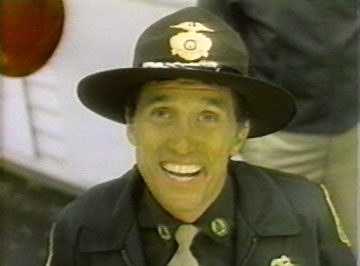
Blitz-Weinhard ownership passed down to Bill and Fred Wessinger, Weinhard’s great-grandsons. They eventually bought out the shares of remaining Blitz and Weinhard descendants.
Old English 800 established itself as a national brand, reaching production of 500,000 barrels a year. But, sales of the flagship brand, Blitz, fell as a result of a national expansion by Anheuser-Busch and its Budweiser brands.
To promote Blitz beer, creative television advertising was launched. The spots featured a persistent border guard on the hunt for a trucker trying to bring California beer into Oregon. The border guard’s mantra is legendary in Oregon adverting history:“Well, now. Where you going with all that beer?”
As memorable as they were, the ads failed to boost sales.
Then the brewery reached into its past to fight for its future. The Henry Weinhard Private Reserve brand began as a special beer to celebrate the Wessinger family’s buyout of the brewery. Fred Wessinger packed up bottles of Henry’s and walked to Jake’s Famous Crawfish restaurant to test the product. It passed the Jake’s test.
In need of a new quality brand, the brewery expanded production of Henry’s ale. Henry’s became a success and is considered a strong influence on the creation of Oregon’s famous microbrew craft beer industry. Henry’s is virtually the only surviving beer in the super-premium category.
1979–99 Brewery Sold and Sold Again
Operating a small regional brewery in competition with larger national beer makers became increasingly difficult. The Wessingers recognized there were no next-generation family members interested in the business at the time. They decided to exit the brewery business while Henry’s was a success and they had something to sell, Bill Wessinger says. The Wessinger family finally sold Blitz-Weinhard to Pabst Brewing Company in 1979.
With new financial resources, and another legendary TV advertising campaign, the sale of Henry’s spread throughout the country. In one TV spot, set in the 1860s, a poker-playing saloon patron offered the vision: “I’ll bet in 100 years Henry’s will be sold as far away as Walla Walla.”
A more farseeing customer, a saloon shaman of sorts, opines: “In 100 years, only girls will ride horses, man will walk on the moon and Henry’s will be sold in New York City.”
In 1983, Pabst was purchased by G. Heileman Brewing Co., based out of Chicago, which combined several regional breweries, including Seattle's Rainier Brewery. Heileman’s expansionist minded owner went bankrupt and Heileman went into a trusteeship with creditors on its board of directors. Once financial stability was achieved – largely on the back of profits from Henry’s and new lines of ales – the brewery was sold to The Stroh Brewing Company in Detroit (1996). There was little marketing support for Henry’s under Stroh.
1999 Blitz-Weinhard Brewery Closed
Although profitable, Stroh sold the Henry Weinhard brand to Miller Brewing Co., which transferred production to the Olympia brewery in Tumwater, Wash. Miller says it will continue brewing Henry’s in the Northwest for Northwesterners.
The five-block Blitz-Weinhard complex was closed and put up for sale. On their last day at work, employees hung their work boots from various high points in the brewery as a parting gesture.
2000 Redevelopment proposed
In January 2000, the complex was purchased by Gerding Edlen, a Portland development firm, which promised to preserve the historic buildings as it redeveloped the land as a mixed use development of office, retail, and residential buildings.
Three historically significant buildings were preserved and renovated: Portland Armory, Weinhard Brewhouse, and Chevrolet Auto Dealership.